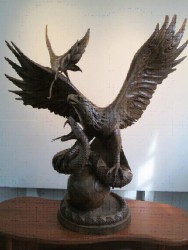In this their third Conversation on Art, artists Stanley Greaves and Akima McPherson tackle a sculpture by Winslow Craig. This piece will be on display from Monday June 8 to Monday June 15 in the second floor gallery, Castellani House.
Akima McPherson: I’m glad we chose Fighting for Global Peace as our first sculpture to discuss. Our choices thus far (Human World and Guiana Land of the Dolorous Garde) are amongst my favourites of the National Collection along with this sculpture by Winslow Craig. I know Craig did it in response to the Gulf War in ’92. He was taken aback by the violent means by which peace was to be restored in the Middle East. As a committed Christian I see he grounded his work in Christian iconography as he integrated an iconographic reference to the US.
Stanley Greaves: On seeing the work, the first thing that is striking is the high degree of technical skill. The other is knowing what to do with it, having something that stimulates the sensibility of the viewer engaging both eye and mind. The detailing of each object is crisp and clear. His work reminds me of the Brazilian Aleijadinho (1738-1814) whose themes were religious and possibly influenced by the complex poses of figures and emotional content of Baroque artists.

Winslow Craig Saaman
1996 (Photo: Courtesy of Winslow Craig)
A.M: Definitely in Craig I see a Baroque sensibility in the work’s form, its directness and clarity, and its high emotional content. For Craig to have arrived at this visually complex form, considering he had to ‘see into’ the tree trunk the potential of this composition, truly impresses me. It is as though he released a form that was trapped within the log, and did not impose a form upon it. It is as though he released its highest potential. So often when I look at local sculpture, the sculptors appear to have worked the wood rather than facilitate the release of the innate-form.
S.G: I think Craig’s approach is having an image or theme in mind then imposing the form on the tree trunk. Some local sculptors do the same, others allow the wood to suggest pure forms which could be considered abstract sculpture. The interest being in form and not a theme. I do not know if sculptors have done any research on sculpture traditions of other cultures, or if this is indeed necessary if one is mainly concerned with self-expression. In Guyana, since the 1970s we have seen the establishment of a tradition in direct carving due to the availability of wood. Apart from a few exceptions, no particular interest has been shown in exploring other media such as welded sculpture, casting, mixed media, terra cotta.
A.M: What are the few exceptions you speak of? In my mind the bronze work of Ivor Thom has on several occasions suggested alternatives in both media and technique.
S.G: Craig himself has been modelling with sawdust and you yourself in the mixed media work in 2012 used glass, wood and wax. Philip Moore was first to use found materials in his constructions. Ivor Thom has also done fine semi-abstract sculptural pieces apart from the monuments which were commissioned.
A.M: Also, in 2012 (Guyana) I showed a large clay work, deliberately unfired. And Craig has done some welding work. But indeed, our sculptors need to break their heavy reliance on wood and take guidance from Philip Moore insomuch as they explore alternative materials.
S.G: I totally agree with you.








